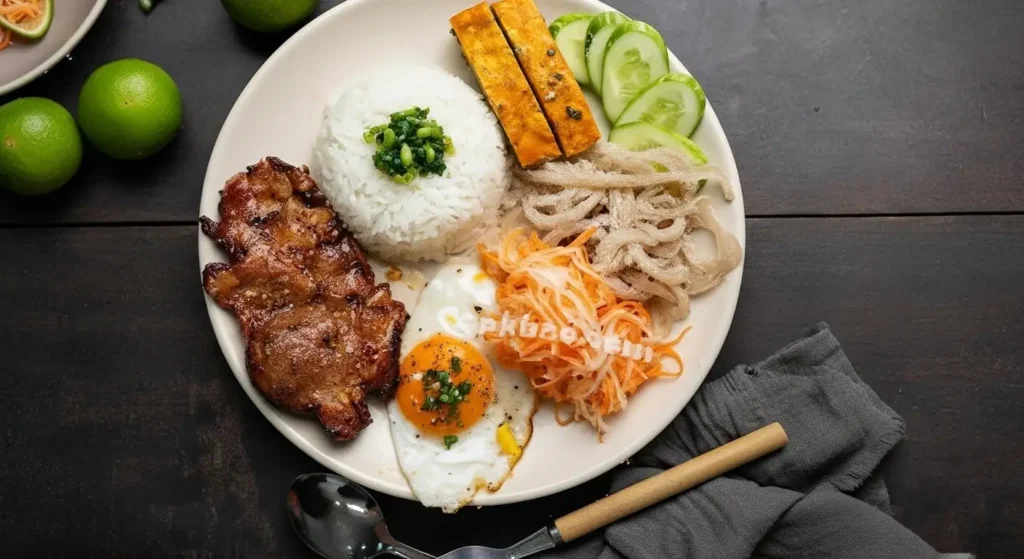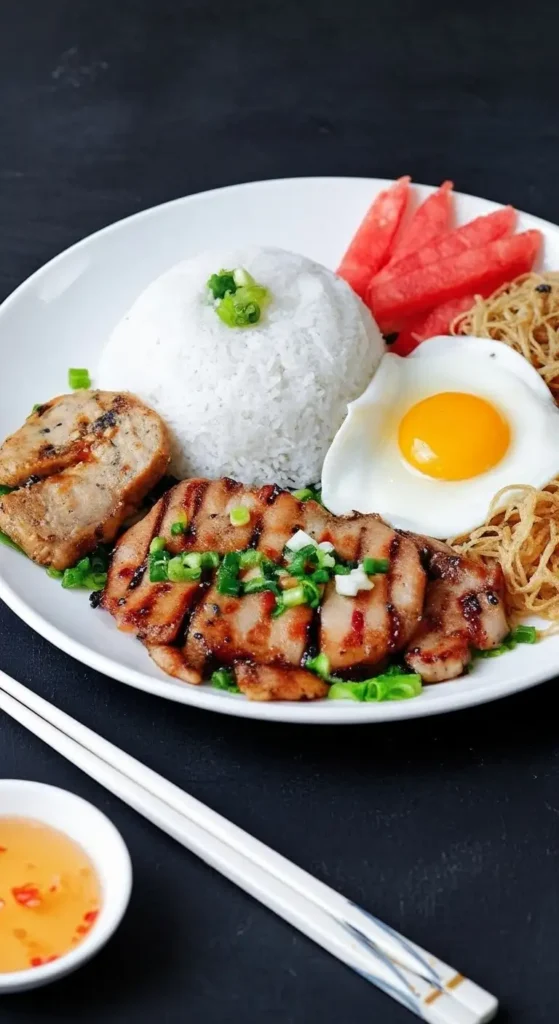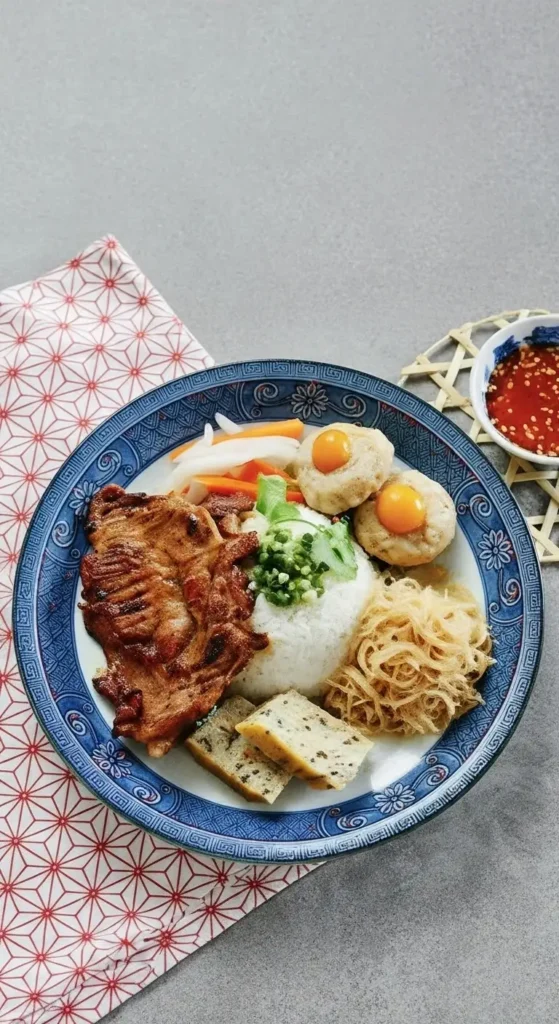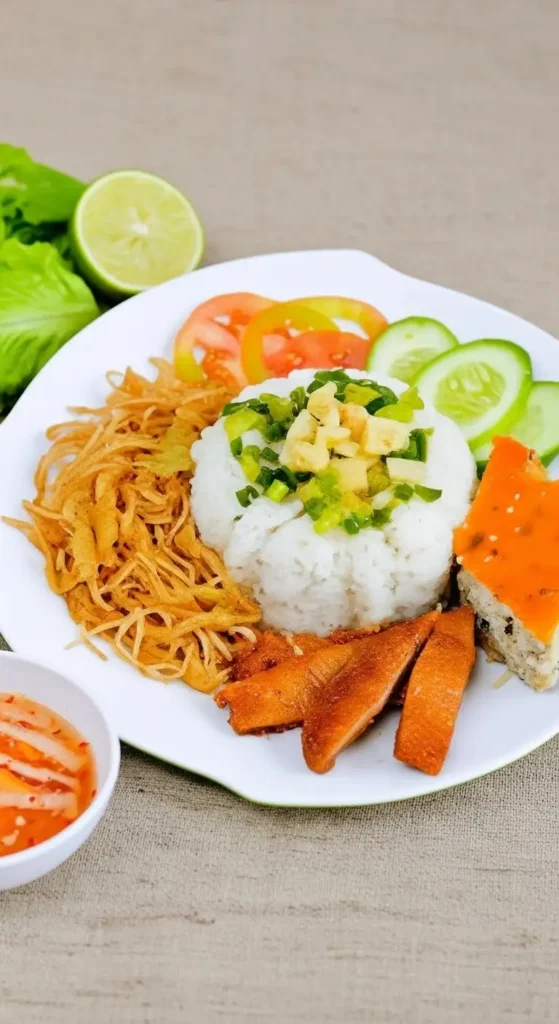Cơm Tấm (pronounced “Com Tum”) is a foundational and iconic dish in Vietnamese cuisine, particularly a signature street food of Southern Vietnam (Saigon/Ho Chi Minh City). More than just a meal, it’s a perfect plate that balances textures and flavors—smoky, savory, sweet, crunchy, fresh, and tangy.
The name literally translates to “Broken Rice” (Cơm = cooked rice, Tấm = broken rice grains), which is the unique foundation of the dish.

Cơm Tấm: The Basics
Broken Rice (Gạo Tấm): Historically, Cơm Tấm originated as a humble dish. Broken rice grains (Gạo Tấm) were fragments broken during the milling process, considered “inferior” and often used for animal feed or by the poor. When cooked, these broken grains have a distinct, slightly chewy, and non-sticky texture that absorbs the sauces beautifully.
The Main Components: A standard plate of Cơm Tấm is a hearty, layered meal, a combination of:
Sườn Nướng (Grilled Pork Chop): A thin, bone-in or boneless pork chop marinated in a rich, sweet-savory mixture of fish sauce, sugar, shallots, garlic, and lemongrass, and then grilled over charcoal until caramelized and smoky.
Mỡ Hành (Scallion Oil): A fragrant topping of finely chopped green onions simmered in hot oil, drizzled over the rice for aroma and richness.
Nước Chấm (Dipping Sauce): A small bowl of the essential Vietnamese dipping sauce, a perfect balance of fish sauce, sugar, lime juice, water, garlic, and chili.
Garnishes: Sliced fresh cucumber and tomato for freshness, and a spoonful of tangy pickled carrots and daikon (Đồ Chua).
Main Types and Components
While the Sườn Nướng (pork chop) is the star, the dish is often a grand platter featuring several other elements. The order is used to name the dish. For example, Cơm Tấm Sườn Bì Chả is the deluxe version.
| Vietnamese Name | Component | Description |
|---|---|---|
| Sườn | Grilled Pork Chop | The most common and famous protein. Thin, caramelized, and smoky. |
| Bì | Shredded Pork Skin | Thinly shredded cooked pork skin mixed with julienned cooked pork and roasted rice powder (thính). It adds a chewy texture and savory aroma. |
| Chả (or Chả Trứng) | Steamed Egg Cake | A steamed savory "meatloaf" or custard made from ground pork, wood ear mushrooms, glass noodles, and egg, often topped with a vibrant yellow egg yolk for color. |
| Trứng Ốp La | Fried Egg | A simple sunny-side-up or fried egg, which adds richness when the runny yolk is mixed with the rice. |
| Tôm | Shrimp | In higher-end versions, grilled shrimp may replace or accompany the pork chop. |

How to Eat Cơm Tấm
Cơm Tấm is a dish that invites the diner to combine all the contrasting flavors and textures into one cohesive, satisfying bite.
Prepare the Sauce: The small bowl of Nước Chấm is crucial. Taste it first and adjust it if necessary (you can add extra chili or lime).
Drizzle Generously: Unlike dipping, the Nước Chấm is meant to be poured over the entire plate—the rice, the meat, the Bì, and the Chả. This sauce is the unifying agent.
Mix and Combine: Use your spoon and fork (it is typically eaten with Western utensils rather than chopsticks due to the rice texture and plate presentation) to slightly mix the rice with the Mỡ Hành and the sauce.
Create the Perfect Bite: Scoop up a mouthful that includes a piece of the smoky pork chop, some Bì (for texture), a sliver of fresh cucumber, and a bit of the soaked, tangy pickled vegetables.
The Broth: Many street stalls will serve a small, light bowl of clear pork broth (nước súp). This is intended to be a palate cleanser or a savory accompaniment to be sipped throughout the meal, not poured onto the rice.
Regional Differences
Cơm Tấm is overwhelmingly a Southern Vietnamese specialty, often referred to as Cơm Tấm Sài Gòn (Saigon Broken Rice). It is less common in its full, classic form in the North and Central regions, where other rice dishes or noodles are more dominant.
| Region | Status & Interpretation | Key Difference |
|---|---|---|
| Southern Vietnam (Ho Chi Minh City) | The Origin and Heart. Cơm Tấm is a daily, all-day staple. | Features the full combination of proteins (Sườn, Bì, Chả, Trứng Ốp La) and is characterized by a very sweet and savory Nước Chấm and the generous use of Mỡ Hành. |
| Central Vietnam (Hue/Da Nang) | Less common; often exists as a simpler rice plate. | The meat might be prepared with a saltier or spicier marinade, reflecting the Central preference for intense flavors. The accompanying side dish might be slightly different local pickles. |
| Northern Vietnam (Hanoi) | Rarely found in its traditional form. | If a similar dish exists, the grilled meat is often replaced with the grilled pork/meatballs from Bún Chả, and the rice itself might be plain white rice rather than broken rice, as broken rice is not a tradition in the North. Northern cuisine generally favors a much lighter, more subtle dipping sauce. |




